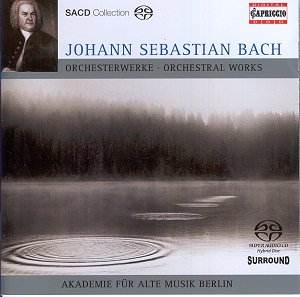Comparison Recordings
BWV 1050:
London Baroque Ensemble/Haas Westminster
LP WN 2211
Mandeal, Members of the George Enescu
PO, AIX 1338 AX DVD-Audio
BWV 1061:
Richter Müller, DECCA ["London"
mono LP] CM 9157
Rafael Puyana, Genoveva Galvéz,
Jenkins, CCO [ADD] Mercury
BWV 1067:
Petri, recorder, Kussmaul, Berliner
Barock Solisten
Galway, modern transverse flute, I Solisti
di Zagreb [ADD] RCA 6517-2 RG
Many fine recordings
over the years have taught me that they
know Bach in Leipzig, so I expected
a lot from this recording, and wasnít
disappointed. These are possibly the
best, or at least equal to the best,
performances of these frequently performed
works Iíve ever heard.
They are very fast,
but there is no sense of the music being
rushed; it simply erupts at this tempo
as if it couldnít help itself, as if
this were the only way it could possibly
be played. Having just finished reading
and reviewing a book on the origins
of our ideas of original performance
practice, this recording is a perfect
example of what it was all about, Bachís
music pretty much the way he played
it and heard it himself. This music
could not have been played this way
fifty years ago, even thirty years ago,
because it was necessary not only to
know, but to get used to knowing, how
to play like this. And, these are chamber
music performances, not "orchestra"
versus "soloist" performances,
again, close to the way we presume it
was played in Bachís time.
The "Brandenburg"
Concerto No. 5 is generally credited
with being the first solo keyboard concerto
ever written, and it was at one time
played on the piano by famous pianists
before famous orchestras. These large
forces required slower tempi, and those
slower tempi tended to stick in the
first recordings for smaller forces.
Then, with the first explorations of
original performance practice, musicians
tried playing faster, uncomfortably
so, because they felt they ought to.
But this performance, the fastest Iíve
ever heard, is also the most natural
sounding. This is more an accompanied
trio, like the Beethoven Op. 56 than
a keyboard concerto. It would be interesting
to hear a performance where the violin
and flute acted like co-soloists and
improvised their own cadenzas at appropriate
places; this would be the final step
in ultimately authenticating this music.
The Concerto in
C may have been originally written
as a duet for harpsichords, and the
orchestral accompaniment may have been
an afterthought.
The Second Orchestral
Suite has been frequently performed
as a solo concerto by flutists such
as Galway, Petri and Rampal, and has
been recorded by Simion Stanciu on the
panpipes and Maurice André on
the trumpet; it always works, of course.
But like the other works on this disk
it is chamber music and while the flute
carries the bulk of the musical responsibility,
everybody should be heard and the interactions
evident. These "Suites" of
Bach are actually "overtures"
in the direct line of ancestry of the
late Haydn symphonies which set the
form for almost all modern symphonies.
Indeed Mahler "modernised"
the orchestration and programmed them
as Bachís "Symphonies" in
Vienna; but this of all the suites is
the least suitable for that treatment,
and the style of this recording comes
closest to the authentic nature of the
work.
The surround sound
perspective is front-centred with ambient
information from the rear channels.
It is a shame the orchestra seating
wasnít expanded so the extra channels
could give us greater separation of
the voices. Some would denounce that
as a "gimmick", but the truth
is chamber music is written to be played
by musicians sitting in a group, close
to each other. Our modern concert hall
perspective, sitting 50 metres away
in the middle of a crowd of 1000 or
more people, a perspective all but unknown
before the nineteenth century, is not
the natural way to listen to chamber
music or any eighteenth century music.
Each player hears the other players
from all around him. It is the audience-versus-stage
perspective in chamber music that is
false, that is the "gimmick."
A surround sound recording of a string
quartet should invariably have one instrument
in each corner of the listening room,
or at the very least, offer a sound
stage of 120 degrees or more. That would
be the most authentic recording perspective,
the one that most closely expresses
the composerís intentions.
An obvious point here
relates to the two harpsichords in the
concerto. They are placed very close
to each other, just to the right of
centre, with harpsichord II just behind
harpsichord I. The writing is a duet
for soloists; they comment on each otherís
lines now and then in question-and-answer
style. Perhaps placing the instruments
close together makes it easier for the
players to hear each other and stay
together, but we, the audience, are
missing out on much of the fun of the
interplay between them. It would be
easy to seat the harpsichordists close
to each other but have the sounding
boards pointing out, and then accentuate
this with microphone placement. The
ideal is what we have from AIX records,
a surround sound "stage mix"
with the instruments in a circle around
the listener; that way the listener
can participate in the music as the
composer intended.
Paul Shoemaker

![]() for
details
for
details 





